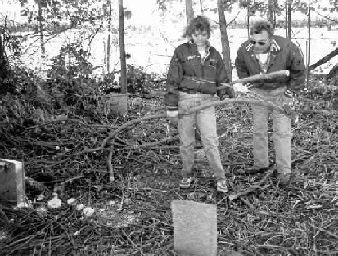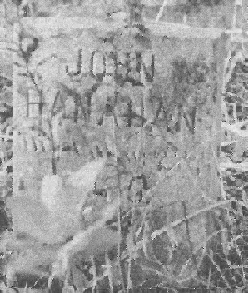|
For Some, Poor Farm was the End of the Line
|
WCC worker Roxanne Tieman and Forestry and Parks Administrator Don Kirn paused from clearing the brush to read a weathered tombstone. |
|
Story and Photos By Jody Conner | |
| This article originally appeared in the September 25, 1986 Edition of the Clark County Press. The county now provides more regular maintenance of the Poor Farm Cemetery. | |
|
Asley C. Satterly saw the sun free and clear for
the first time in many years last Tuesday. Not that he was physically
present to enjoy the sight, having died in 1882. But he probably would
have appreciated the efforts being made to clear his grave of overgrown
vegetation and the refuse of grazing cattle.
In the days before social welfare programs, nursing homes, and mental health facilities, there was only one place for Clark County residents to go when they could not care for themselves. The County Poor Farm. And as the 83 gravestones in the old Poor Farm Cemetery can attest, the trip to the farm was the end of the line for many of them, Satterly included. Even in death, fate was not kind to them. For the better part of 40 years their graveyard has not been maintained. Little was done to combat the inroads weeds and saw grass. Eight-inch trees grew up around and on some the graves.
| |
|
Only wild flowers have decorated the grave of John Hanahan since he
passed away in 1926. |
This past week, following a County Board appropriation of $1,000, worker’s from the Wisconsin Conservation Corp began clearing away years of neglect. The last time any work was done at the site was in 1968, according to Don Kirn, Forests and Parks administrator, who is overseeing the project. Brush and trees will be removed, fallen tombstones reset and a fence erected to keep out the cows, according to Kirn. That the departed could lay unattended for so long is of little wonder. Most of those who resided at the farm were destitute, with no relatives to take them in or kin to mourn their death. They left few records behind, other than scant bits of information gleaned from their death certificates. Some were immigrants who had left their families in Europe. Men like Chris Rossow, 65, who was born in Germany and stayed single his entire life before "heart exhaustion" killed him in 1906. Or Pat Vaughn, who was born in Iceland to Irish parents, and lived at the farm 12 years before passing away at age 80 in 1913. Others were widows and widowers, bachelors and spinsters, living out their last lonely years. The farm was even home to a number of orphans, waiting to be either adopted or sent to a more proper orphanage.
|
|
The history of the farm goes back to September of 1867, when the County Board voted to abolish the distinction between "town poor and county poor." The board allocated $1,000 to purchase the necessary land and erect buildings for a poor farm, according to county board minutes. Welfare costs proved hard to estimate even then. A year later the county purchased 160 acres at a prices of $2,500. Bills for the cost of operations must have upset some on the board. They narrowly defeated a resolution to abolish the Poor Farm on a 4-4 vote in June of 1870. |
|


